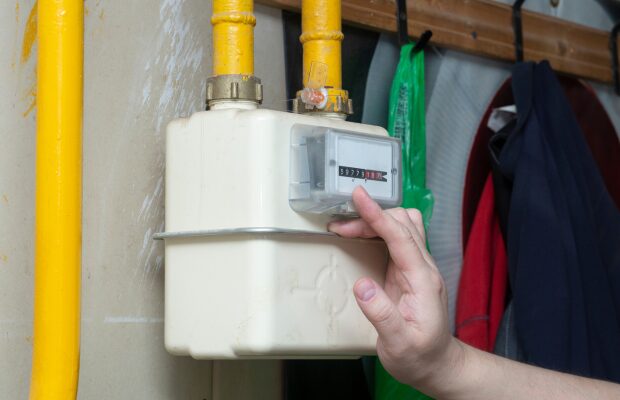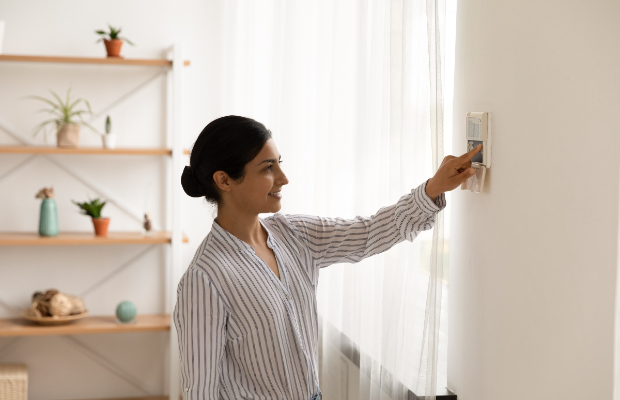Winter means increased energy use as we heat our homes to keep out the chill.
And with energy bills rising, taking steps to winter-proof your home could save you some vital cash.
Not only that, but if you’re thinking of selling or renting out your property, an energy efficient home is likely to be extremely appealing to potential buyers and tenants.

Source: Dataloft, Bloomberg, Ofgem, The Heating Hub
“Although an annual price cap of £2,500 has been announced for two years, this is still a significant increase on last winter,” advises Dataloft.
“A gas boiler has the biggest impact on bills and buyers may look to reduce costs by choosing well-insulated homes and those which use renewable energy sources or energy-efficient boilers.
“How we select and use our appliances will also have an effect, with gas hobs using less energy than electric.
“Full loads in dishwashers and washing machines will trim costs and Smart Meters are a great way for raising awareness of usage.”
In this guide, we reveal some of the best ways to winter-proof your house, keep the heat in and save money on your energy bills.
What temperature is too cold for a house?
Any property
with an interior temperature below 14°C could cause serious health problems to the people living there.
Health guidance recommends that your home is heated to between 19-21°C for rooms occupied during the day.
At night, it’s recommended to heat occupied bedrooms to 18°C.
Room temperatures of above 24°C could also cause health problems in babies and small children.
What is the best way to warm your home?
The best and most cost-effective way to warm your home is by keeping as much heat inside as possible.
Certain things you can do to improve your property’s energy efficiency and lower your bills will require a budget and a professional to do the work.
But there are also simple steps you can take yourself to keep heat inside your property.
You could consider:
1. Draught-proofing your home
Eliminating draughts will make your home feel warmer, meaning you’ll use less energy and could save money on your bills.
Cracks in flooring, or gaps around doors and windows are the most common cause of draughts in the home.
How to draught-proof windows
To draught-proof windows, you can use self-adhesive foam strips around the frames which will seal any gaps or cracks.
Sash windows may require a brush-style strip which will stay in place when the window is opened or closed.
How to draught-proof doors
Draught-proof your external doors by:
- Covering the keyhole with sliding metal disc
- Using adhesive brush strips around letterboxes and cat flaps
- Fitting a hinged draught excluder to the bottom
Internal doors that lead to rooms you don’t use, or heat, should stay closed to stop cold air filtering into the rest of your home.
You can also eliminate draughts from the base of internal doors by using draught excluders.
Draught-proofing floorboards and skirting
Draughts are common in gaps between flooring and skirting boards, especially in older homes.
Because the wood contracts and expands with changes in temperature, using a flexible sealant or filler is the best way to eliminate these draughts.
| DIY or expert required? | Budget required |
| Most draught-proofing work can be done yourself, but you may require expert help for sash windows or single-glazing in older properties | Keyhole cover: £1 – £3
Letterbox brush: £10 Draught excluder: £6 Silicone sealant / filler: £5 – £10 |
2. Getting your boiler serviced
The best way to keep your boiler running efficiently and eliminate the chances of it breaking down is through annual servicing.
Common boiler problems during winter include:
- Leaks
- Low or no pressure
- Kettling or noise
- No heating or hot water
- The boiler not starting up through the thermostat
- A pilot light switching off
The best way to find solutions for these problems is through an annual service, which will highlight any issues with your boiler’s performance before they become serious.
| DIY or expert required? | Budget required |
| A boiler service should always be carried out by a Gas Safe Engineer | One-off service: £60 – £100
Boiler cover insurance: £200 – £300 per year |
3. Consider home insulation
Insulating your home to modern standards can help to keep more heat inside and lower your heating bill.
Types of insulation you could consider include:
Cavity wall insulation
If your home was built after 1920, it should have a cavity wall.
By filling the cavity with modern insulation, your home should stay warmer with less heat escaping through the brickwork.
Floor insulation
Most modern homes have solid concrete ground floors and rigid insulation can be laid on top to stop heat escaping through the floor.
If you live in an older home, you may have a suspended timber floor and this can be insulated either by laying insulation wool between the joists or with a spray foam insulation which sticks to the underside of your floorboards.
Loft insulation
It’s estimated around 25% of a property’s heat is lost through the roof, but loft insulation can be a great way to reduce that.
If your roof space is free of damp issues and you have a pitched roof, adding rolls of insulation between the joists is a straightforward job.
However, while insulating your loft should make your home feel warmer, your roof space will be colder.
So, be sure to insulate water tanks and pipework to stop them freezing in the winter.
| DIY or expert required? | Budget required |
| Installing cavity wall insulation will usually require an expert, but timber floor and loft insulation can often be completed on a DIY basis | Cavity wall insulation: £200 per exterior wall
Loft insulation (DIY): £300 – £400 Floor insulation: £70 – £200 per m2 plus labour |
4. Improve your windows
The average UK home is estimated to lose as much as 10% of its heat through its windows.
Replacing your windows with modern, energy efficient units is a great way to keep heat in, but the work will usually require a professional and a budget.
When replacing your windows for new energy efficient units, you’ll need to consider:
The glazing
The most energy efficient windows are either double or triple glazed, with one or two gaps between the panes which are filled with inert gas and sealed.
Low-E glass is the most energy efficient for double and triple glazing, as this has a coating of metal oxide that reflects heat back into the home.
Single glazed windows are the least energy efficient and are often found in older properties or listed buildings.
Double glazing windows are rated A++ to G for their energy efficiency, with A-rated windows more energy efficient but more costly to install.
Frame material
uPVC frames are most common in modern homes, and these are both energy efficient and low maintenance.
Older properties, listed buildings or those in conservation areas often have wooden frames which can still be efficient but do require more maintenance.
| DIY or expert required? | Budget required |
| While fitting new windows can be done if you’re an experienced DIYer, in most cases it will require a professional window fitter | uPVC double glazing: £200 – £700 per unit depending on style, glass and size |
5. Bleed your radiators
If your radiators aren’t heating up properly, or they’re cold at the top, they probably have air trapped inside and require bleeding.
Getting the air out of your radiators will help your boiler perform better and this can help save money on your bills.
To bleed your radiators, you should:
- Make sure your heating is off and the radiators are cold
- Start with the radiator furthest away from your boiler downstairs, then repeat upstairs
- Hold a jug or cloth under the radiator valve and insert your bleed key
- Turn the key anti-clockwise until you hear a hissing noise
- Once the hissing stops and water starts coming from the valve, turn the key clockwise and tighten the valve
| DIY or expert required? | Budget required |
| Radiator bleeding is straightforward and can be done yourself | Radiator bleed key: £1 – £3 |
6. Improve your heating system controls
Installing modern heating controls can give you more options with how and when you heat your home – saving you money.
Room thermostats and timers
A modern thermostat with a timer means you can heat your home to certain temperatures at different times of the day without having to do anything.
By placing thermostats in different rooms, you can also get more control over the areas of your property that you heat.
Smart thermostats such as Hive, meanwhile, mean you can control your heating through your phone even when you’re not there.
Thermostatic radiator valves
These are valves that fit to your radiators, so you can control how much heat comes from each one.
By installing these valves, you can turn down the heat in rooms you don’t use and turn it up where you need it.
Valves that work with smart heating systems are also available, which can be controlled through voice assistants like Alexa or Google Home.
Smart meters
Smart meters show you how much energy you’re using in real time and can be a great way to hold yourself accountable through simple awareness.
| DIY or expert required? | Budget required |
| Installing radiator valves and thermostats can be done yourself, but if you’re uncomfortable dealing with water systems, a professional is recommended | Programmable thermostat: £30 – £250
Thermostatic radiator valve: £12 – £50 Smart meter: Free if rolled out by your energy supplier |
What is the cheapest way to keep your house warm?
Even if you don’t have a budget for major energy efficiency work, there are still plenty of cheap ways to keep your house warm, including:
1. Turning down your thermostat
It’s possible to save money on heating simply by turning down your thermostat by a single degree.
It’s likely you’ll barely notice the difference between having your thermostat set at 18°C rather than 19°C – but that single degree difference could save you up to £60 per year.
2. Open curtains, blinds, or shutters during the day
Even if it’s cold outside, a bright winter day with plenty of sun can be free heating for your home.
Open curtains, blinds, and shutters during the day to let in the light and heat – especially with larger windows.
As soon as the sun drops, though, close everything up again to keep the heat in.
Heavy or thermal curtains can be a great way to do this, but even closed blinds and shutters can stop heat escaping from your home in the evenings.
3. Arrange your furniture in an energy-efficient way
If your furniture is blocking radiators in your home, you might be trapping heat that could be warming your rooms.
By moving items like sofas or units away from radiators, you’ll allow the heat they produce to circulate the room.
This could also mean you’re able to turn down your thermostat by a degree or two, saving you more money on your bills.
4. Use a radiator reflector
For radiators fixed to external walls, a reflector panel fixed to the back can help deflect heat back into your room rather than it escaping through the wall.
Radiator reflecting foil costs as little as £7, while a fixed radiator reflector is likely to cost you around £30.
5. Leave the oven door open after cooking
If you’re cooking food in your oven, leaving the door open once everything is cooked and the oven is off can be a great way to add some warmth to your kitchen in the winter.
Because you’ve already paid for the heat to cook your food, leaving the door open to allow the heat to warm your kitchen is essentially free.








